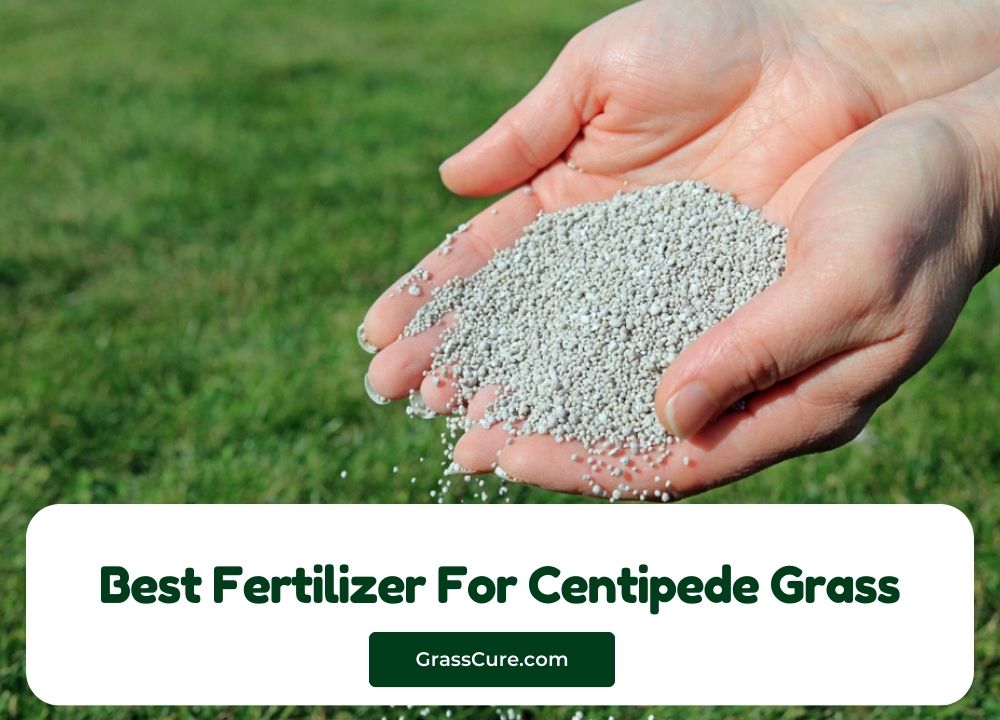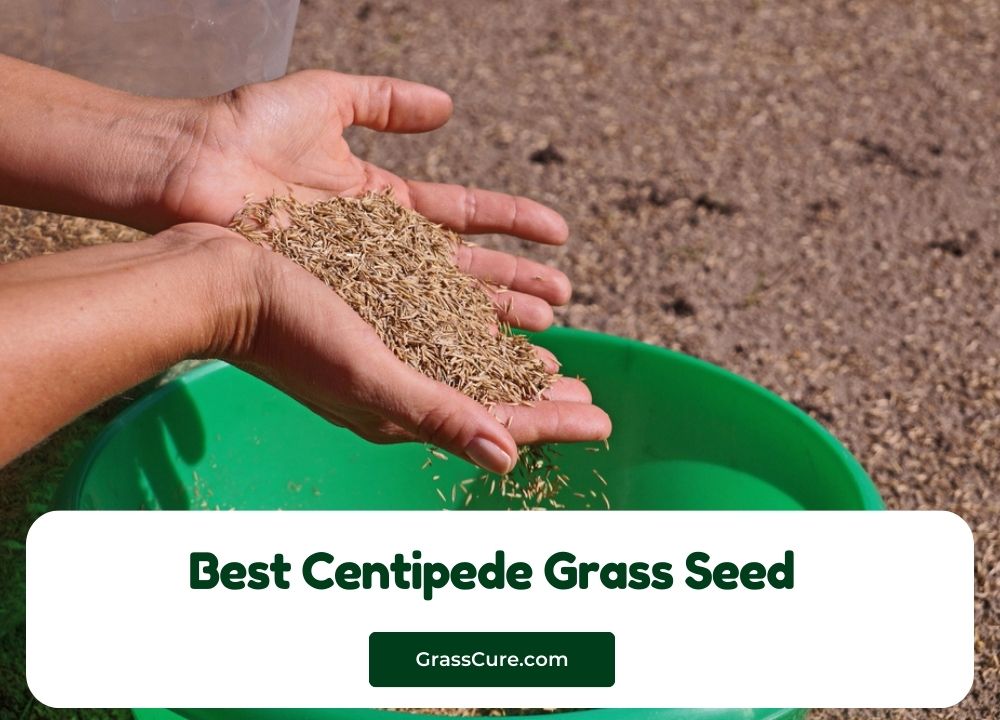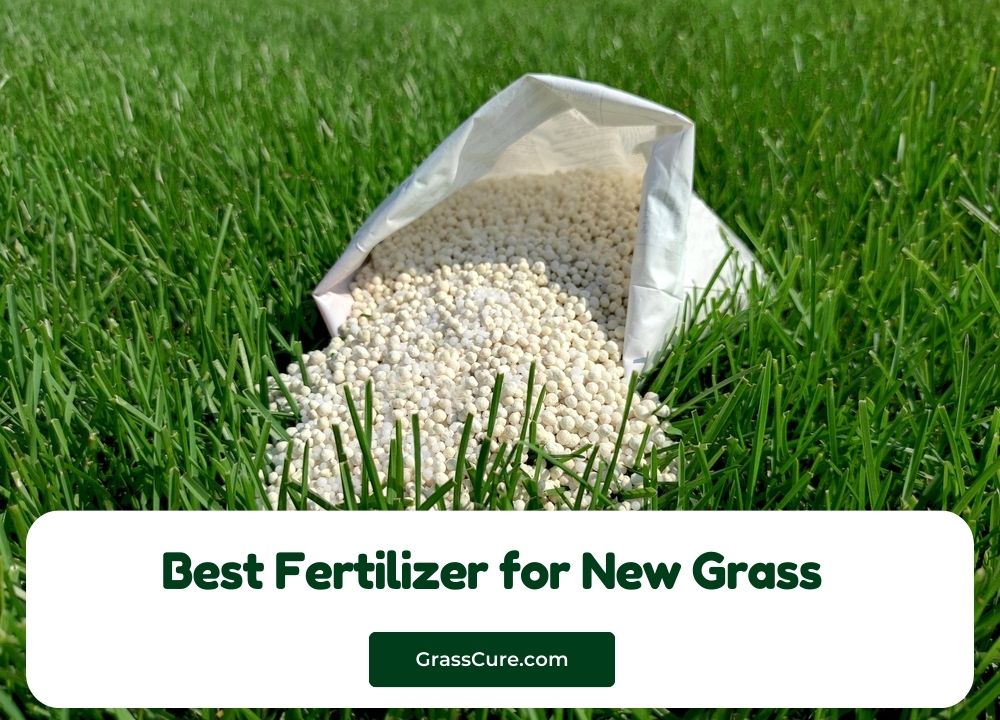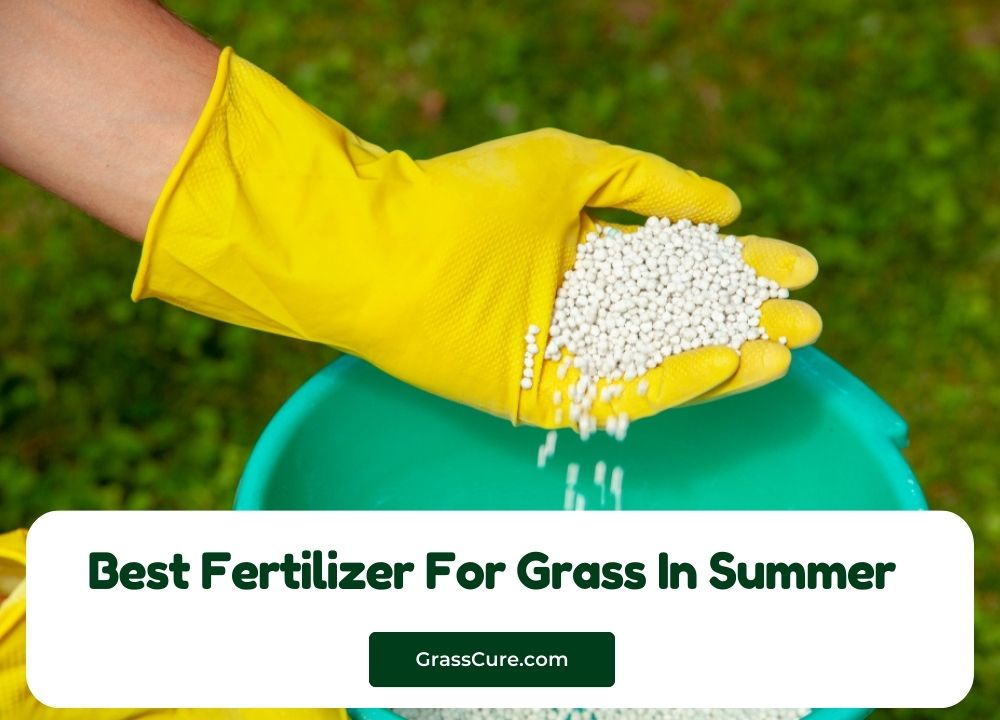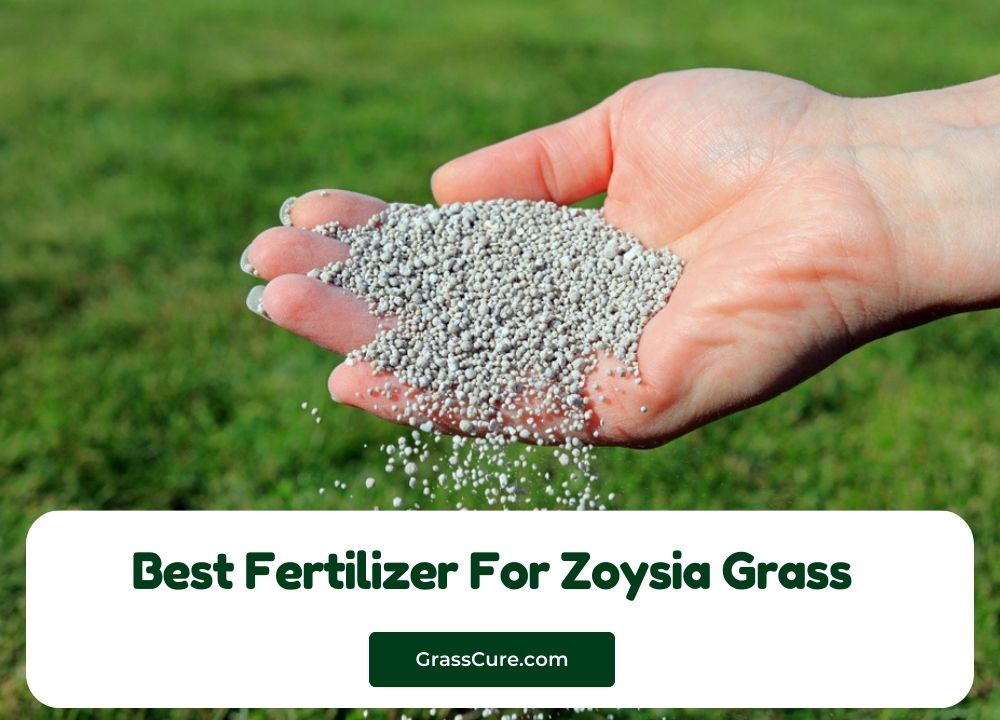Centipede grass is a popular choice for lawns in warm climates due to its low-maintenance nature and ability to thrive in acidic soils. However, keeping this grass lush and healthy requires the right fertilizer. Using a fertilizer specifically suited to centipede grass ensures it receives the nutrients it needs without risking damage from over-fertilization. In this guide, we’ll explore the best fertilizers for centipede grass to help you maintain a beautiful, green lawn all season long.
Contents
Understanding Centipede Grass
Centipede grass is known for its slow-growing, low-maintenance qualities, making it ideal for homeowners who prefer a lawn that requires less care. It thrives in warm, humid regions and grows best in acidic soil with a pH between 5.0 and 6.0. Unlike other grass types, centipede grass doesn’t need high levels of nitrogen, which makes it more sensitive to over-fertilization. Its ability to spread and form a dense, carpet-like lawn makes it popular in the southeastern U.S. However, proper care, including the right fertilization, is essential to maintain its health and vibrancy.
Factors to Consider When Choosing Fertilizer for Centipede Grass
Soil pH
- Centipede grass thrives in acidic soil with a pH range of 5.0 to 6.0. Testing your soil’s pH before choosing a fertilizer is essential to ensure optimal nutrient absorption.
Nutrient Requirements
- Centipede grass has low nitrogen needs compared to other grasses, requiring a balanced fertilizer with a higher potassium content. A ratio such as 15-0-15 (low nitrogen, no phosphorus, high potassium) is ideal for promoting healthy root growth without encouraging excessive top growth.
Type of Fertilizer
- Organic vs. Synthetic: Organic fertilizers provide slow-release nutrients and improve soil health over time, while synthetic fertilizers offer faster results but may require more frequent applications.
- Liquid vs. Granular: Liquid fertilizers are absorbed quickly and are ideal for correcting deficiencies, whereas granular fertilizers offer slow-release feeding and are easier to apply evenly.
Climate and Seasonal Needs
- Centipede grass grows best in warm climates, so fertilizers designed for southern lawns are often the most suitable. The timing of fertilizer application is also crucial, as centipede grass should typically be fertilized in late spring or early summer for the best results.
Selection of the Best fertilizers for centipede grass
1.Fertilome (10767) Centipede Lawn Fertilizer 15-0-15 (20 lbs.)
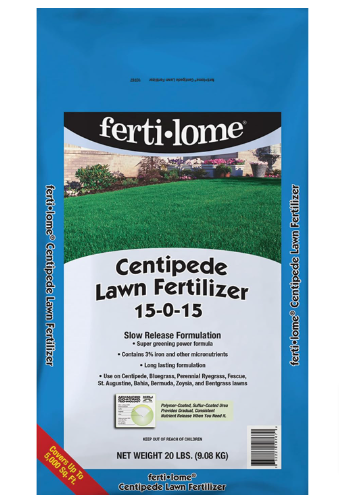
Overview: Fertilome Centipede Lawn Fertilizer is specifically formulated to meet the nutrient needs of centipede grass. With a balanced 15-0-15 NPK ratio, this fertilizer provides the essential nitrogen and potassium that centipede grass requires, while omitting phosphorus, which is typically unnecessary for this grass type. It’s an excellent choice for homeowners who want to maintain healthy, green centipede grass lawns with minimal effort.
Key Features:
- NPK Ratio: 15-0-15 (15% nitrogen, 0% phosphorus, 15% potassium) – ideal for centipede grass, promoting healthy growth without overstimulating the grass with excess nitrogen or phosphorus.
- Potassium for Root Strength: The high potassium content helps strengthen the roots and improves the grass’s resilience against stress, drought, and disease.
- Slow-Release Formula: Provides continuous feeding over time, helping to maintain a healthy, green lawn throughout the growing season.
Benefits:
- Encourages steady growth and vibrant green color without overstimulation.
- Phosphorus-free formula, tailored for centipede grass, reduces the risk of nutrient imbalance.
- Promotes strong root development and improved drought tolerance.
- Easy to apply and suitable for use on both new and established lawns.
Application Tips:
- Best applied in late spring or early summer when centipede grass is actively growing.
- Use a broadcast or drop spreader for even coverage, and water the lawn after application to help the fertilizer absorb into the soil.
- Reapply as needed throughout the growing season, generally every 6-8 weeks, to maintain lawn health.
2. Scotts Turf Builder Southern Lawn Fertilizer for Southern Grass (10,000 sq. ft., 28.12 lbs.)
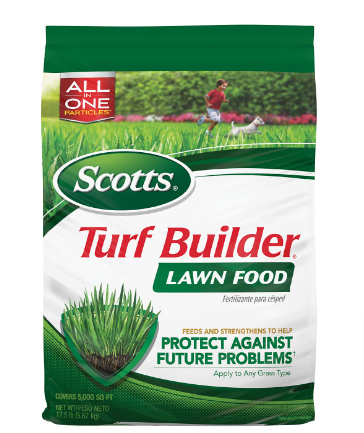
Scotts Turf Builder Southern Lawn Fertilizer is specifically designed for grasses commonly found in warmer climates, like centipede grass, St. Augustine, and Bermuda. It helps strengthen grass against the challenges of heat and drought, making it ideal for maintaining a lush lawn in southern regions.
Key Features:
- Coverage: Treats up to 10,000 square feet, ideal for large lawns.
- Formulation: Balanced nutrients that promote strong root growth and grass resilience, without overloading the soil with excess nitrogen.
- Southern Climate Adaptability: Designed to handle the heat and drought common in southern climates, providing essential nutrients for optimal grass health.
- All-in-One Particle Technology: Ensures even distribution of nutrients, minimizing the risk of over- or under-fertilizing any specific area.
Benefits:
- Strengthens grass roots to better withstand heat and drought.
- Encourages thicker, greener lawns without causing excessive growth.
- Easy to apply with a broadcast or drop spreader.
Application Tips:
- Best applied in late spring or early summer when centipede grass begins to grow actively.
- Water your lawn after applying to help activate the fertilizer and improve nutrient absorption.
3. Superior Nitrogen & Potash 15-0-15 NPK- Lawn Food Natural Liquid Fertilizer
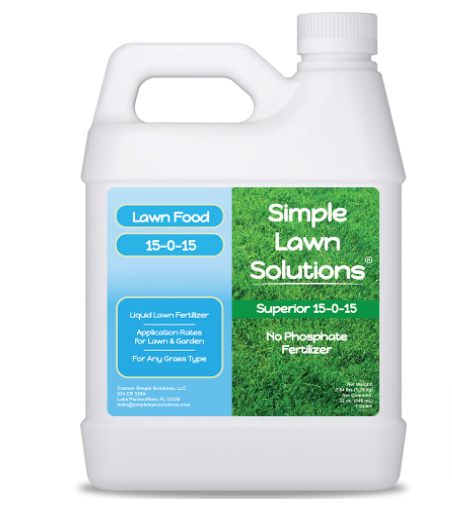
Superior 15-0-15 Liquid Fertilizer is a high-quality, phosphorus-free lawn food designed to promote healthy grass growth across various grass types, including centipede grass. With a focus on nitrogen and potassium (potash), it supports green, healthy growth and strong roots, ideal for lawns that need a nutrient boost without excessive phosphorus. This product also includes humic acid and kelp seaweed for soil health and improved nutrient uptake.
Key Features:
- NPK Ratio: 15-0-15 (15% nitrogen, 0% phosphorus, 15% potassium) – a balanced formula ideal for centipede grass, which thrives with low phosphorus and high potassium.
- Concentrated Liquid Formula: Easy-to-apply liquid concentrate that can be sprayed directly on the lawn.
- Additional Ingredients: Contains humic acid and kelp seaweed, which improve soil health and increase nutrient absorption, contributing to stronger root systems and improved grass resilience.
- Versatility: Suitable for all grass types, making it an excellent option for mixed lawns or uncertain grass types.
Benefits:
- Promotes vibrant green color and steady growth without over-stimulating the grass.
- Strengthens grass roots, enhancing drought tolerance and resilience.
- Phosphorus-free, making it safe for centipede grass, which requires minimal phosphorus.
- Easy-to-apply with a hose-end sprayer, making feeding your lawn quick and efficient.
Application Tips:
- Ideal for use during the active growing season of centipede grass (spring and summer).
- For best results, apply every 4-6 weeks and water the lawn after application to ensure the nutrients are absorbed effectively.
4. Scotts Turf Builder Southern Triple Action (8,000 sq. ft., 26.64 lbs.)
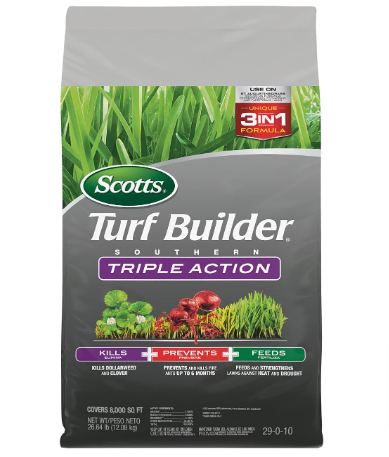
Scotts Turf Builder Southern Triple Action is a multi-purpose lawn care product designed specifically for southern grasses, including centipede grass. This product combines three essential functions: it kills weeds, prevents fire ants for up to six months, and feeds the lawn with essential nutrients. It’s an excellent all-in-one solution for maintaining a healthy, green lawn in warm climates.
Key Features:
- Three-in-One Formula:
- Weed Control: Effectively kills stubborn weeds like dollarweed, clover, and dandelion.
- Fire Ant Prevention: Provides protection against fire ants for up to six months, reducing the need for separate insecticide treatments.
- Fertilization: Feeds the lawn with nutrients to promote strong, green growth.
- Coverage: Treats up to 8,000 square feet, making it suitable for medium to large lawns.
- Southern Climate Specific: Specially formulated for warm-season grasses like centipede, St. Augustine, and Bermuda grass.
Benefits:
- Eliminates common weeds without harming the grass.
- Protects the lawn from damaging fire ants, making it safer for family and pets.
- Feeds the grass, promoting stronger roots and a thicker, greener lawn.
- Simplifies lawn care with its combined weed control, pest prevention, and fertilization.
Application Tips:
For optimal results, avoid using it on newly seeded lawns or within four weeks of seeding.t until they appear or make a disaster in your lawns. Its preventive function is very effective and is still an excellent fertilizer.
5. Commercial Grade Lawn Energizer – Grass Fertilizer Booster (1 Gallon)
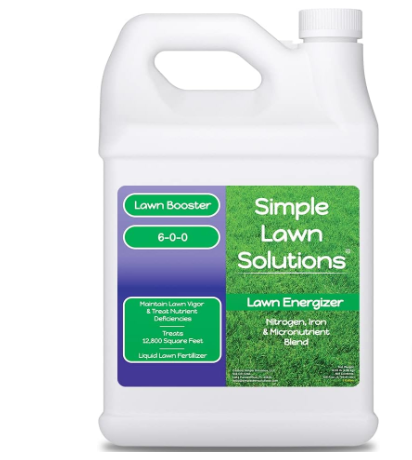
The Commercial Grade Lawn Energizer by Simple Lawn Solutions is a concentrated liquid fertilizer booster designed to energize and enhance the color and growth of your lawn. It is enriched with nitrogen, iron, and essential micronutrients to quickly green up any grass type, including centipede grass. This liquid fertilizer is ideal for homeowners looking for a powerful, easy-to-apply solution to give their lawn an immediate boost in health and appearance.
Key Features:
- Nutrient-Rich Formula: Contains high levels of nitrogen and iron, promoting vibrant green color and healthy growth.
- Micronutrients: Includes additional micronutrients that improve overall lawn health and stress tolerance.
- Liquid Concentrate: Easy-to-use liquid formula that can be applied with a hose-end sprayer for even coverage.
- Versatility: Suitable for all grass types, including warm-season grasses like centipede grass, St. Augustine, Bermuda, and Zoysia.
Benefits:
- Provides a quick, visible green-up of the lawn due to the high iron content.
- Nitrogen promotes vigorous growth and helps repair any damage to the lawn.
- Micronutrients enhance nutrient uptake and overall grass health.
- Convenient application, ideal for homeowners who want fast results with minimal effort.
Application Tips:
Reapply every 4-6 weeks for continued lawn health and color improvement.
Apply during the growing season for centipede grass (spring and summer) when the grass is actively growing.
Use a hose-end sprayer to evenly distribute the product across your lawn.
Water the lawn after applying to ensure the fertilizer penetrates the soil and is absorbed by the roots.
Fertilizing Tips for Centipede Grass
- Know Your Soil:
- Before fertilizing, test your soil to determine its pH and nutrient levels. Centipede grass thrives in acidic soil with a pH between 5.0 and 6.0. Adjust your soil pH if necessary using lime or sulfur as needed.
- Choose the Right Fertilizer:
- Select a fertilizer with a low nitrogen content and a higher potassium ratio, such as 15-0-15. Avoid fertilizers with high phosphorus levels, as centipede grass requires minimal phosphorus.
- Timing is Key:
- Fertilize during the active growing season, typically in late spring or early summer, when centipede grass starts to green up. Avoid fertilizing in the fall or winter when the grass is dormant.
- Frequency of Application:
- Generally, fertilize every 6-8 weeks during the growing season. This helps maintain consistent nutrient levels without over-stimulating the grass.
- Application Method:
- Use a broadcast or drop spreader for even distribution of granular fertilizers. For liquid fertilizers, apply using a hose-end sprayer for uniform coverage.
- Water After Fertilizing:
- Water your lawn immediately after applying fertilizer to help the nutrients penetrate the soil and reach the roots. This also prevents potential burn from concentrated fertilizers.
- Observe Your Lawn:
- Monitor your centipede grass for signs of nutrient deficiency or over-fertilization, such as yellowing leaves or excessive growth. Adjust your fertilization practices based on these observations.
- Avoid Over-Fertilizing:
- Excessive nitrogen can lead to rapid growth, making your lawn more susceptible to pests and diseases. Stick to recommended rates and application intervals.
- Consider Seasonal Changes:
- Adjust your fertilization schedule based on weather conditions. If the summer is particularly hot and dry, you may need to reduce the frequency of fertilization or the amount applied.
- Supplement with Organic Matter:
- Incorporating organic matter, like compost, can improve soil health and provide additional nutrients, enhancing the overall condition of your centipede grass.
Buying Guide for Fertilizers for Centipede Grass
When purchasing fertilizer for centipede grass, it’s essential to consider several factors to ensure you select the right product for your lawn’s needs. Here’s a comprehensive buying guide to help you make an informed decision:
1. Understand Nutrient Needs
- NPK Ratio: Look for fertilizers with a low nitrogen (N) content (preferably between 10-20%) and a higher potassium (K) content (around 15%). The ideal ratio for centipede grass is often 15-0-15 or similar. Avoid phosphorus (P), as centipede grass requires minimal amounts.
- Micronutrients: Consider fertilizers that include essential micronutrients like iron and magnesium, which can enhance grass color and overall health.
2. Type of Fertilizer
- Granular vs. Liquid: Granular fertilizers provide slow-release nutrients, ideal for long-lasting feeding. Liquid fertilizers can offer quicker results but may require more frequent applications.
- Organic vs. Synthetic: Organic fertilizers improve soil health and provide a more gradual nutrient release. Synthetic fertilizers can deliver immediate results but may lead to soil degradation if used excessively.
3. Application Method
- Ease of Use: Choose fertilizers that come with clear application instructions. Some products are easier to apply than others, so consider your comfort level with spreading or spraying.
- Coverage Area: Check how much area the fertilizer covers. Products that cover larger spaces can be more cost-effective for larger lawns.
4. Seasonal Considerations
- Growing Season: Ensure that the fertilizer is suitable for use during the growing season of centipede grass (late spring to early summer). Look for products specifically labeled for southern grasses or warm-season lawns.
5. Environmental Impact
- Eco-Friendly Options: If you’re concerned about environmental impact, consider organic fertilizers or those with natural ingredients. These options can minimize the risk of runoff and harm to beneficial organisms.
6. Brand Reputation
- Trustworthy Brands: Look for established brands with positive customer reviews. Brands known for producing quality lawn care products often provide better results and customer satisfaction.
7. Price and Value
- Budget-Friendly Options: Compare prices among various brands and types of fertilizers. Sometimes, investing a little more in a high-quality fertilizer can lead to better results and a healthier lawn in the long run.
8. Packaging Size
- Quantity: Consider the size of your lawn and purchase an appropriate amount of fertilizer. Larger packages might be more economical but ensure you can use them before their expiration date.
9. Additional Features
- Weed and Pest Control: Some fertilizers come with added benefits, such as weed control or insect prevention. If your lawn struggles with pests or weeds, these all-in-one options might save you time and effort.
10. Read Reviews and Recommendations
- Customer Feedback: Look for reviews from other users who have fertilized centipede grass. Their experiences can provide insight into the effectiveness and ease of use of the product.
Conclusion
Selecting the right fertilizer for centipede grass is crucial for maintaining a vibrant, healthy lawn that can thrive in warm climates. By understanding the unique nutrient needs of centipede grass and considering factors such as NPK ratios, application methods, and seasonal timing, you can make informed decisions that promote optimal growth.
Whether you opt for granular or liquid fertilizers, organic or synthetic options, the key is to choose products tailored to the specific requirements of centipede grass while avoiding common pitfalls like over-fertilization. With the right care and nutrition, your centipede lawn can flourish, providing a beautiful green space for relaxation and enjoyment. Remember to monitor your lawn’s health and adjust your fertilization practices accordingly to achieve the best results year-round.
FAQs About Fertilizing Centipede Grass
1. How often should I fertilize centipede grass?
- Generally, centipede grass should be fertilized every 6-8 weeks during the growing season (late spring to early summer). Always follow the instructions on the fertilizer label for specific recommendations.
2. What type of fertilizer is best for centipede grass?
- Look for fertilizers with a low nitrogen content and a higher potassium ratio, such as a 15-0-15 NPK ratio. Phosphorus should be minimal or absent, as centipede grass requires very little.
3. Can I use regular lawn fertilizer on centipede grass?
- It’s best to use fertilizers specifically formulated for centipede grass, as regular lawn fertilizers may contain high levels of nitrogen or phosphorus, which can harm the grass.
4. When is the best time to fertilize centipede grass?
- The optimal time to fertilize centipede grass is during the active growing season, usually in late spring or early summer, when temperatures are warm and the grass is green and healthy.
5. What signs indicate that my centipede grass needs fertilizer?
- Signs include yellowing grass, stunted growth, or a generally sparse appearance. If your lawn lacks vibrancy or color, it may benefit from fertilization.
6. Can I over-fertilize centipede grass?
- Yes, over-fertilizing can lead to rapid, unhealthy growth, making the grass more susceptible to pests and diseases. Stick to recommended application rates to avoid this issue.
7. Should I water my lawn after applying fertilizer?
- Yes, watering your lawn after applying fertilizer helps activate the nutrients and encourages absorption by the grass roots. It’s essential to follow up with watering to prevent fertilizer burn.
8. Is organic fertilizer better for centipede grass?
- Organic fertilizers can improve soil health and provide gradual nutrient release, making them a good choice for many homeowners. However, synthetic fertilizers can also be effective if used appropriately.
9. How can I test my soil’s pH and nutrient levels?
- You can purchase a soil testing kit from a garden center or send a soil sample to a local extension service for analysis. This will help you understand your soil’s current condition and guide your fertilization strategy.
10. Can I use weed control products alongside fertilization?
- Some fertilizers contain weed control, but it’s essential to read the product labels carefully. If using separate products, apply them at different times to avoid damaging the grass. Always follow label instructions for safe and effective use.
References
- University of Georgia Extension. (n.d.). Centipedegrass: A warm-season turfgrass for the southeastern United States. Retrieved from [UGA Extension](https://extension.uga.edu/publications/detail.html?number=C 1034).
- Texas A&M AgriLife Extension. (n.d.). Fertilization of Centipedegrass. Retrieved from Texas A&M.
- Florida Cooperative Extension Service. (2011). Lawn Fertilization. Retrieved from University of Florida.
- The Lawn Institute. (n.d.). Understanding Lawn Fertilizers. Retrieved from Lawn Institute.
- National Gardening Association. (n.d.). Choosing and Using Fertilizers for Lawns. Retrieved from Gardening Help.
- Simple Lawn Solutions. (n.d.). Centipede Grass Fertilizer Recommendations. Retrieved from Simple Lawn Solutions.
- Scotts Miracle-Gro. (n.d.). Fertilizing Your Lawn: A Guide to Lawn Care. Retrieved from Scotts.
- Fertilome. (n.d.). Centipede Lawn Fertilizer Product Information. Retrieved from Fertilome.
